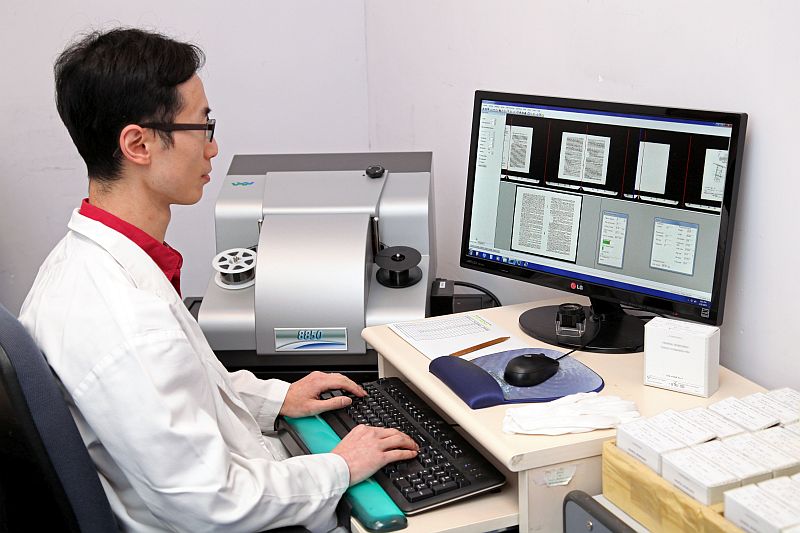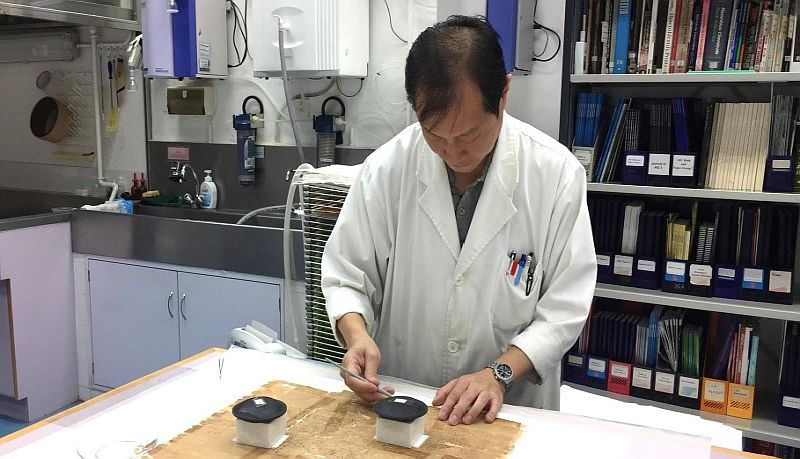Silent Contributors
Unique / Routine
“The duties of photographers, printing technicians and workmen seem unrelated. Yet, they are closely linked with each other.”
Photography, printing and ironing – what have they to do with the Government Records Service (GRS)? Let’s see if you can get a clue here from our colleagues, Photographer Mr Benny Chan Ka-chung, Printing Technician Mr Luk Yiu-fai and Workman Mr Chong Ching-wai, who share their experience of having a job unlike others.
Microfilming: to Keep Archives for 500 Years
Professional photographers usually take pictures of people, landscapes or commercial products. So did Mr Chan until he joined GRS and discovered a very “unusual” photography here – his “models” become archives and his photographic works end up in the form of microfilms.
When asked about the skills required for working in GRS, Mr Chan replied, “Film development is not only a nostalgic hobby of some photography enthusiasts, but also an expertise crucial to my job in GRS.” The reason is, part of his main responsibilities is to convert the paper records of government bureaux/departments into microfilms. “Microfilms can save storage space. What’s more, they can preserve records for as long as 500 years if they are properly handled and stored,” added Mr Chan.
Strict quality control is essential to the production of microfilms. Mr Chan explained, “Besides photo-taking, quality control is also one of my duties. I have to check the exposure, resolution, etc. of the microfilms carefully according to International Standard ISO 9001, so as to ensure that the image quality of the microfilms is as good as the originals.”
In recent years, Mr Chan has also participated in the digitisation of archives. To meet the ever-changing needs of digitisation in future, he and his colleagues will continue to keep their knowledge updated, make use of a wider range of computer software and equipment and keep an eye on the latest products on the market.

Conservation Treatment: a Meticulous Handicraft
Mr Luk once worked as a bookbinder when he was a Printing Technician in the Government Logistics Department. Familiarity with the book production process and a sound knowledge of different paper types have contributed to his solid foundation in the field. This “affinity” with paper continued after his transfer to GRS. As he helps conserve paper records, his experience in bookbinding comes in handy. For Mr Luk, records conservation is a specialised handicraft. “Machines could be an aid in my previous bookbinding job, but no longer so now. Records conservation is very much a ‘handicraft’ – we conserve sets of paper records with hands and a few tools.” Archives with historical value must be handled with great care, so one must have a pair of nimble hands in order to do a good conservation job.
Records conservation is time-consuming, stressed Mr Luk. “To start with, we have to clean the damaged document, add moisture to loosen the fibres and flatten it. Only then can the treatment begin. Depending on the conditions of individual records, the treatment may take several months to complete.” He admitted that records conservation required “on-the-job learning”. “Using specialised solutions and chemicals to treat yellowed or mouldy paper records is one of the many I learned it from colleagues after joining GRS. Besides, different records require different treatments. Some are more complicated and difficult to handle. I discussed with my colleagues whenever I got stuck. Together, we would figure out and adopt suitable options to conserve the records. I’ve been benefited a lot from the course.”
To support the work of records conservation, more Printing Technicians have been posted to GRS in recent years. With his rich experience, Mr Luk assists in supervising and training the new-comers, in addition to his everyday duties, so that they could master the conservation skills and pass on experience and wisdom.

Ironing: to Smooth Things out
If you have ever visited GRS to access its collections, you may recall being asked to put on gloves before touching the holdings. GRS has dedicated staff for ironing gloves to ensure that they are neat and tidy. Mr Chong is the “Ironman” who is tasked with the ironing work. “GRS staff and visitors must wear cotton gloves when handling archives. This isn’t just for comfort, but also for preventing any contamination of the items,” explained Mr Chong. “I collect the used gloves, check their conditions, arrange for cleaning, and perform the ironing.” Public requests for access to archives have increased in recent years, and Mr Chong saw himself more or less an observer for GRS, “Look at the number of gloves I handle on a day and you’ll know how many people have accessed the archives.” Despite the increased workload, Mr Chong is delighted to see the greater importance given to archives, which in turn makes his work more rewarding.
Surprisingly, the usage of the iron does not stop here. “Before their destruction, inactive records of government bureaux/departments may be sent to GRS for microfilming. I conduct the preparation, such as removing staples and rubber bands, and ironing the paper to avoid damage caused by rolling actions of microfilming equipment,” said Mr Chong. Heat helps loosen paper fibres and flatten paper, like it does when ironing clothes. “To avoid damage,” Mr Chong added, “we use a dry iron to iron documents. I also need to adjust the ironing temperature to fit different types of paper. Thermal paper like fax paper will turn black if heated.” Ironing is not as simple as we thought!
The duties of these three colleagues seem unrelated, but Mr Chong saw it another way round. “In fact, our works are closely linked with each other. After I’ve ironed a document, I hand it over to the Photographers to produce microfilms. When I’m not certain about the property of a piece of paper, I’ll seek advice from the Printing Technicians right away.”

There are challenges, but all three of them will keep working faithfully and continue their stories of unusual endeavours.